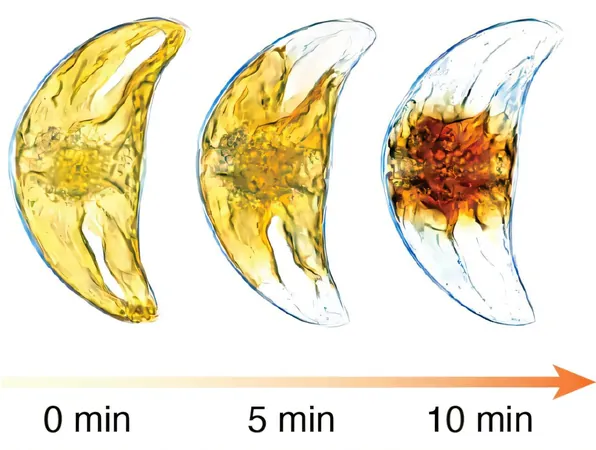
Unlocking Nature’s Secrets: How Tiny Algae Outsmart Blinding Light!
2024-11-18
Author: Daniel
Introduction
We've all been there: basking in the lovely rays of sunshine until it gets a bit too intense, prompting us to seek shelter or take a refreshing siesta. But what about those tiny, non-moving single-celled organisms? How do they cope when the sunlight becomes overwhelming? Recent groundbreaking research from the University of Amsterdam has shed light on this fascinating topic!
Introducing Pyrocystis lunula
Introducing Pyrocystis lunula, a remarkable single-celled alga better known among sailors and fishermen for its mysterious ability to illuminate the ocean with a glowing blue hue. This captivating organism is part of the dinoflagellate family and relies predominantly on sunlight for its energy, utilizing chloroplasts—specialized structures that convert sunlight into usable chemical energy.
Challenges Faced by P. lunula
While plants employ a clever trick to avoid excess sunlight by rearranging their chloroplasts to shade one another, P. lunula faces a unique challenge. With its chloroplasts woven into an intricate network, this micro-organism can’t simply shift them around or move out of the light like animals or humans. How does it tackle the problem of excessive sunlight?
Innovative Research
A team of innovative biophysicists—Nico Schramma, Gloria Casas Canales, and Maziyar Jalaal—has employed advanced microscopy techniques to observe the behavior of P. lunula’s chloroplasts when exposed to varying light conditions. They uncovered a stunning fact: while these chloroplasts cannot flee the light, they can cleverly minimize its damaging effects by shrinking in size!
Adapting to Light Conditions
When drenched in bright white light—akin to a dazzling summer day—the chloroplast compacts to a ball-like shape, reducing its size by an impressive 40% within just five minutes. As the lighting shifts to a gentler red hue, it takes merely half an hour for the chloroplast to return to its original form.
The Mechanism Behind Flexibility
But what allows this remarkable flexibility? The answer lies in a network of delicate, thin filaments that create a structure capable of contracting and expanding in all directions. This unique ability is extraordinarily rare in nature. For instance, if you were to step on a lemon, while it would squash down, it would simultaneously spread outwards, transforming into a flat, disk-like shape. Not so for P. lunula, which elegantly sidesteps this typical behavior.
Implications and Applications
This fascinating mechanism has drawn intriguing parallels to the Hoberman sphere—an inventive design conceived by Chuck Hoberman in 1988 that inspires popular toys. The implications of this discovery extend far beyond biology; they also touch on mathematics, specifically the field of topology, and materials science.
Future Explorations
Researchers remain captivated by the potential applications for lab-made materials that mimic the astonishing properties of P. lunula’s chloroplasts. These "smart materials" could undergo significant transformations in response to external stimuli, revolutionizing design and engineering.
Conclusion
When scientists unravel a single mystery, often it leads to a cascade of new inquiries and revelations. The understanding of how P. lunula and its dinoflagellate cousins navigate the challenges of bright light not only enriches our knowledge of these enigmatic creatures that intermittently paint our oceans with light but also enlightens us about the natural world’s intricate structures, mathematical principles, and innovative design inspirations.
As we delve deeper into nature's playbook, who knows what other astonishing revelations await? Stay tuned!


 Brasil (PT)
Brasil (PT)
 Canada (EN)
Canada (EN)
 Chile (ES)
Chile (ES)
 España (ES)
España (ES)
 France (FR)
France (FR)
 Hong Kong (EN)
Hong Kong (EN)
 Italia (IT)
Italia (IT)
 日本 (JA)
日本 (JA)
 Magyarország (HU)
Magyarország (HU)
 Norge (NO)
Norge (NO)
 Polska (PL)
Polska (PL)
 Schweiz (DE)
Schweiz (DE)
 Singapore (EN)
Singapore (EN)
 Sverige (SV)
Sverige (SV)
 Suomi (FI)
Suomi (FI)
 Türkiye (TR)
Türkiye (TR)